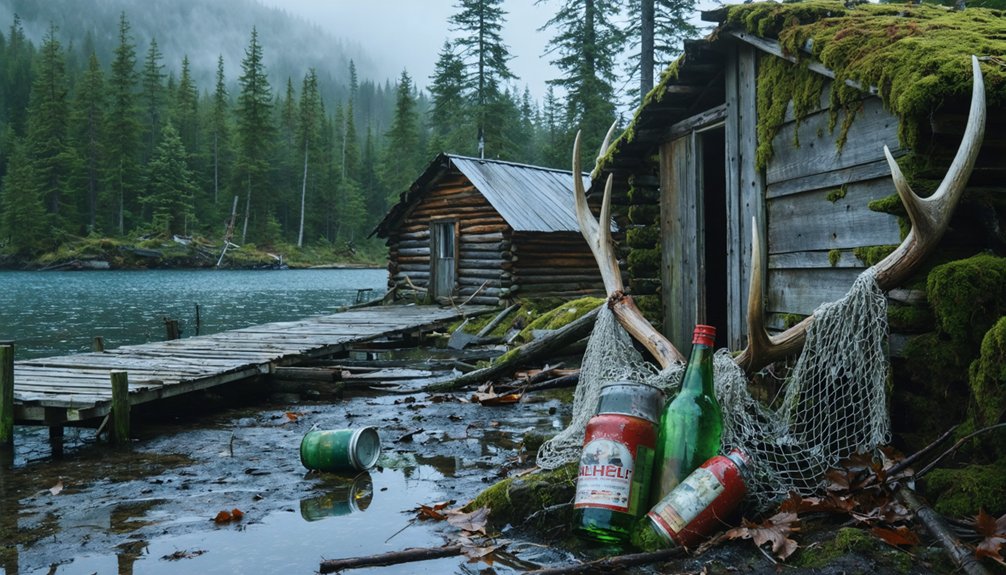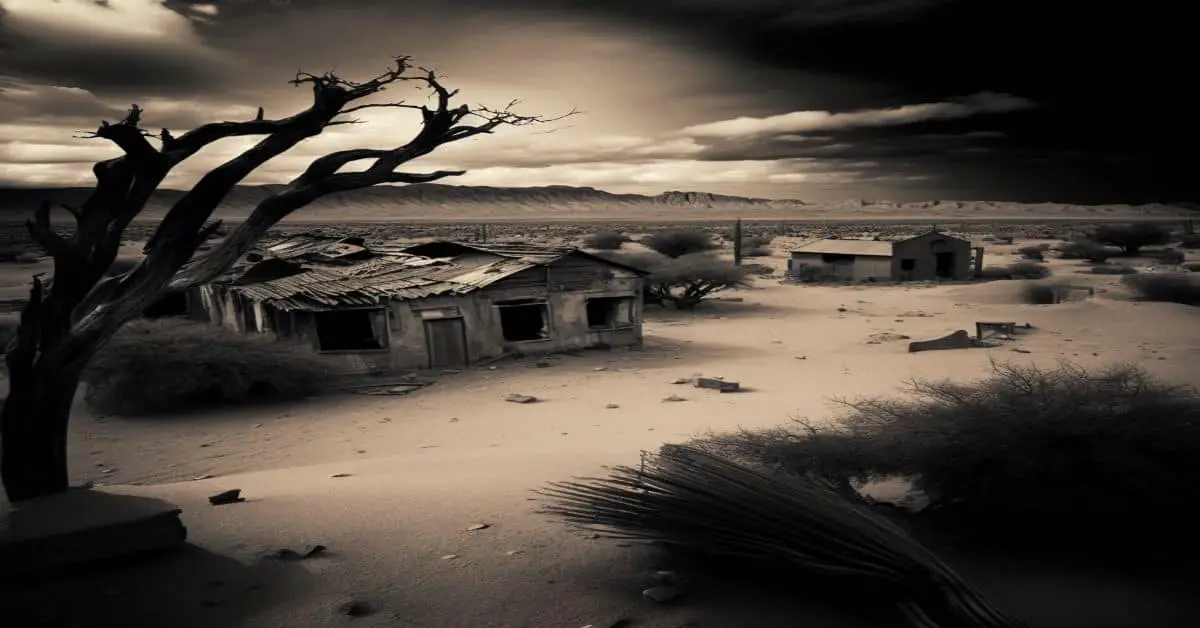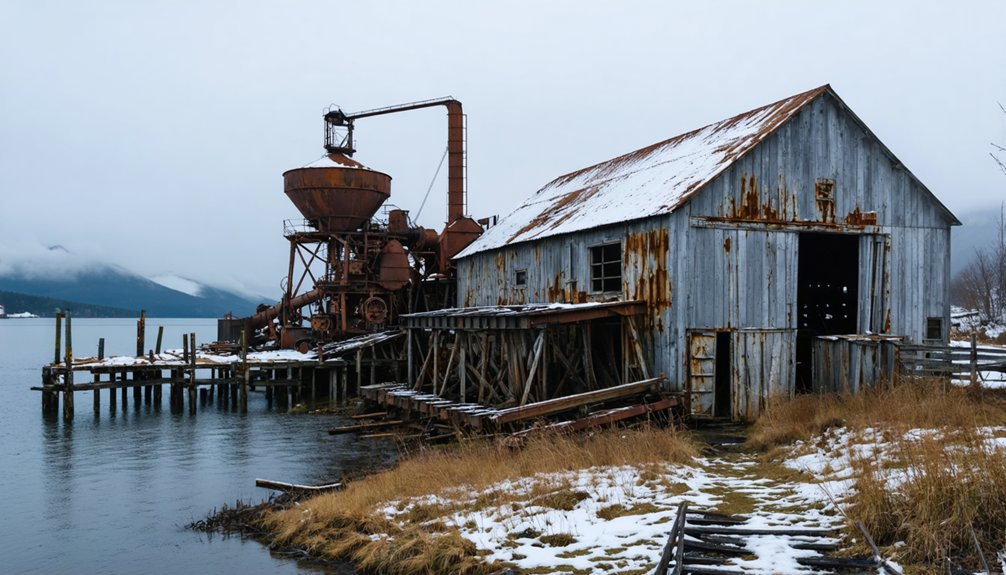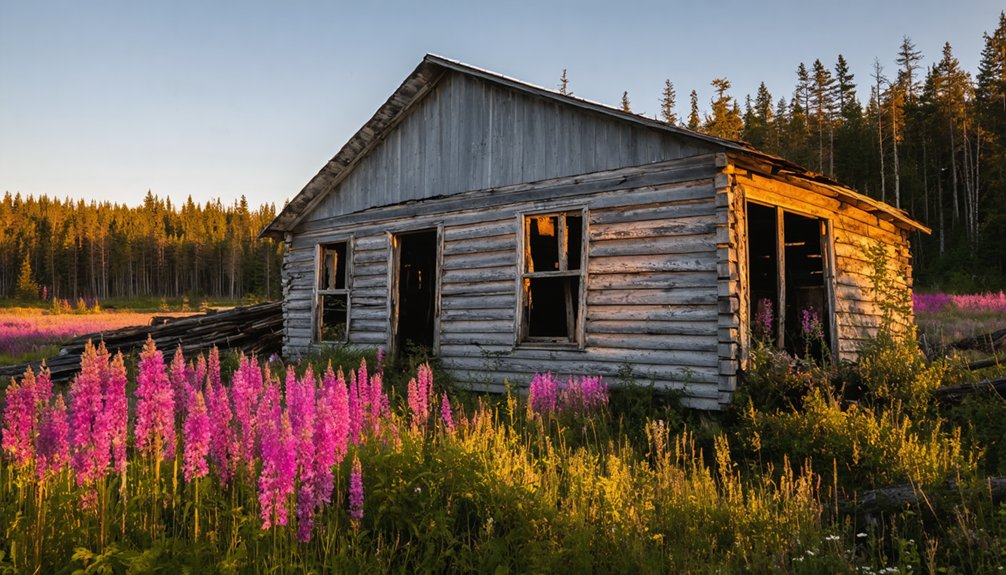You’ll find Afognak’s ghost town ruins on Alaska’s Kodiak Archipelago, where indigenous Alutiiq people lived continuously for over 7,500 years. The village thrived as a Russian-indigenous settlement until 1964, when North America’s most powerful earthquake struck. The devastating 9.2 magnitude quake and subsequent tsunamis forced residents to abandon their homes and establish Port Lions 19 miles away. The deserted site holds centuries of fascinating cultural fusion and resilience beneath its surface.
Key Takeaways
- Afognak became a ghost town after the devastating 1964 Great Alaska Earthquake forced residents to abandon their village.
- The village combined indigenous Alutiiq and Russian influences, visible in its division between Nasqualek (Aleut Town) and Taryuq (Russian Town).
- Residents relocated to establish Port Lions following the earthquake, leaving behind centuries of continuous settlement history.
- Archaeological evidence shows 7,500 years of indigenous habitation before abandonment, including well-preserved cultural artifacts and building foundations.
- The former settlement sits empty but maintains cultural significance for descendants who preserve connections through oral histories and cultural events.
Early Settlement and Indigenous Roots
While indigenous peoples inhabited much of Alaska’s coastal regions, the Alutiiq people established particularly deep roots on Afognak Island, maintaining continuous settlements there for over 7,500 years. Their indigenous heritage centered around the village of Ag’waneq near the salmon-rich Afognak River, where they built both permanent settlements and seasonal camps to maximize the area’s abundant resources.
You’ll find evidence of their settlement patterns in the evolution of their housing, from simple family dwellings to large planned houses that showcased social organization and leadership. Communities would often return to original sites after periods of temporary relocation. The village was divided into two distinct sections called Nasqualek and Taryuq, representing Aleut Town and Russian Town respectively.
The Alutiiq people’s technological innovation is clear in their development of ground slate tools, while their strategic placement of villages near marine and riverine resources demonstrates their deep understanding of the local environment. Their settlements reflect a sophisticated society that thrived through well-organized subsistence practices.
Russian Colonial Influence and Cultural Fusion
As Russian fur traders first ventured into the Kodiak Archipelago in the 1760s, they forever changed Afognak’s cultural landscape through their pursuit of sea otter pelts.
The arrival of Russian fur traders in Kodiak marked a pivotal shift, as their sea otter hunts transformed Afognak forever.
You can trace their influence through the establishment of Grigorii Shelikhov’s trading post in 1786, which became a crucial outpost for the Russian-American Company’s operations.
The cultural exchange between Russians and indigenous Sugpiat (Alutiiq) people created a unique blend of traditions, despite initial conflicts.
You’ll find evidence of this fusion in the colonial architecture of traditional “octopus” houses, which combined Russian and indigenous building styles.
Russian Orthodox Christianity took root, while intermarriage between settlers and natives formed a distinct Creole population.
Though the Russians’ aggressive fur trade disrupted native life, their legacy endures in the region’s religious practices and architectural heritage.
The Three Saints Bay settlement on nearby Kodiak Island served as the first permanent Russian colony in Alaska, established in 1784.
By the 1820s, the Russian-American Company workforce had declined significantly, leading to the creation of retirement communities.
The Great Alaska Earthquake and Village Exodus
When the most powerful earthquake ever recorded in North American history struck south-central Alaska on March 27, 1964, it released devastating consequences for the village of Afognak. The 9.2 magnitude quake‘s impact triggered violent shaking for nearly five minutes, followed by destructive tsunamis that reached heights of up to 70 meters. The massive earthquake sparked eleven major aftershocks that continued to threaten the region.
The earthquake’s effects were felt across 502,000 square miles of territory, demonstrating its extraordinary magnitude and reach. You’ll find that Afognak’s community resilience was tested as the village faced catastrophic damage from the combined effects of ground movement, land subsidence, and powerful tsunami waves.
The destruction of critical infrastructure, including docks and fishing facilities, left residents with an impossible choice. Rather than rebuild in an area now proven geologically unstable, many villagers chose to relocate. They established a new community called Port Lions, marking the end of Afognak’s era as an inhabited settlement.
Birth of Port Lions: A Community Reborn
Following the devastation of Old Afognak, roughly 40 families commenced on establishing a new community at Settlers Cove in 1964, located 19 air miles west of Kodiak, Alaska.
The Kodiak Island Lions Club stepped in with essential support, helping construct homes and infrastructure, which inspired the new settlement’s name: Port Lions.
You’ll find remarkable community resilience in how these displaced residents maintained their Alutiiq heritage while embracing modern progress.
The Native Village of Port Lions gained federal recognition in 1978, growing from 225 to over 400 tribal members.
Through their Traditional Tribal Council, they’ve fostered cultural preservation by blending subsistence lifestyles with contemporary services, including healthcare, education, and economic development initiatives. The council actively promotes Alutiiq dance and arts through various cultural programs.
Many residents maintain their Russian Orthodox faith, reflecting the enduring influence of the Russian period.
Russian Orthodox traditions continue to influence their vibrant community life.
Legacy and Archaeological Significance
Deep beneath the soil of Afognak Island lies over 7,500 years of rich indigenous history, with archaeological evidence suggesting human habitation since the deglaciation period 12,000 years ago.
You’ll find remarkable cultural resilience in the Alutiiq people’s endurance through Russian colonization, epidemics, and natural disasters, including the devastating 1964 Good Friday earthquake and tsunami.
Though the physical village now stands empty, archaeological sites reveal historical continuity through ancient settlement patterns, colonial-era interactions, and traditional subsistence practices.
The descendants maintain their connection to ancestral lands through oral histories, cultural events, and heritage projects.
While Afognak’s residents relocated primarily to Port Lions after 1964, their preserved stories and archaeological remains continue to provide essential insights into Alaska Native life, adaptation, and survival through centuries of change.
The island’s complex coastline and ice-free waters enabled year-round hunting and fishing activities, supporting the thriving maritime culture of its inhabitants.
Originally consisting of settlements along a curving beach, Afognak village showcased the traditional coastal living patterns of its native inhabitants.
Frequently Asked Questions
Are There Any Dangerous Wild Animals on Afognak Island Today?
While 3,500 Kodiak brown bears roam nearby, you’ll mainly need wildlife safety precautions around them on Afognak Island. Bear encounters are rare, but they’re the only truly dangerous animals there.
Can Tourists Visit the Abandoned Afognak Village Site?
You can visit the site but tourist access is limited. You’ll need special permits and transportation arrangements since it’s on private Native corporation land requiring permission for site preservation purposes.
What Traditional Alutiiq Festivals Were Celebrated in Old Afognak?
Time-honored traditions never die. You’d find the Alutiiq people celebrated winter festivals with singing, drumming, and dancing in communal houses, honoring animal spirits while sharing stories and feasting together.
How Did Residents Heat Their Homes During Harsh Alaskan Winters?
You’d rely on wood stoves and oil heaters to keep warm, with 79% of households using diesel fuel systems. You’d store plenty of firewood and heating oil for those long winter months.
What Happened to the Cemetery After the Village Was Abandoned?
You’ll find the cemetery largely undisturbed, with stone slabs up to 75cm protecting many graves. Memorial records document burials from the late 1800s, while the site maintains its historical significance under Native Village preservation.
References
- http://afognak.org/education/history_intro.php
- https://en.wikipedia.org/wiki/Afognak
- https://www.afognak.org/data-recovery/ancient-afognak/
- https://en.wikipedia.org/wiki/List_of_ghost_towns_in_Alaska
- https://www.youtube.com/watch?v=Cz0IGc2Uy0E
- https://live.laborstats.alaska.gov/sites/default/files/trends/may24art2_0.pdf
- https://www.thealaskalife.com/blogs/news/alaska-ghost-towns-youve-probably-never-heard-of
- https://alutiiqmuseum.org/alutiiq-people/history/villages/
- http://www.afognak.org/education/history_chapter3.php
- http://www.afognak.org/heritage/history/history-intro.php?src=ancient-afognak



